Constant Temperature Approach for the Assessment of Injection Molding Parameter Influence on the Fatigue Behavior of Short Glass Fiber Reinforced Polyamide 6
Abstract
1. Introduction
- (i)
- the influence of injection molding parameters
- (ii)
- improve the reliability and comparability of the gathered information regarding the fatigue properties of GFC.
2. Materials and Methods
2.1. Materials
2.2. Injection Molding
2.3. Tensile Testing
2.4. Fatigue Testing
2.5. X-ray Microtomography Analysis of the Composite Structure
3. Results
3.1. Tensile Properties
3.2. Self-Heating—Adjusted Frequency for Constant Change in Temperature
3.3. Fatigue Properties
3.4. X-ray Microtomography Analysis of Composite Structure
3.5. Volume Correlation
4. Conclusions
Author Contributions
Funding
Institutional Review Board Statement
Informed Consent Statement
Data Availability Statement
Conflicts of Interest
References
- Erden, S.; Ho, K. Fiber reinforced composites. In Fiber Technology for Fiber-Reinforced Composites; Seydibeyoğlu, M., Mohanty, A., Misra, M., Eds.; Woodhead Publishing Series in Composites Science and Engineering; Woodhead Publishing: Duxford, UK, 2017; pp. 51–79. [Google Scholar]
- Schoßig, M. Schädigungsmechanismen in Faserverstärkten Kunststoffen: Quasistatische und Dynamische Untersuchungen; Vieweg+Teubner (GWV): Wiesbaden, Germany, 2011. [Google Scholar]
- Schürmann, H. Konstruieren mit Faser-Kunststoff-Verbunden; Springer Science and Business Media LLC: Berlin/Heidelberg, Germany, 2005. [Google Scholar]
- Capela, C.; Oliveira, S.; Ferreira, J. Fatigue behavior of short carbon fiber reinforced epoxy composites. Compos. Part B Eng. 2019, 164, 191–197. [Google Scholar] [CrossRef]
- Eftekhari, M.; Fatemi, A. Variable amplitude fatigue behavior of neat and short glass fiber reinforced thermoplastics. Int. J. Fatigue 2017, 98, 176–186. [Google Scholar] [CrossRef]
- Launay, A.; Marco, Y.; Maitournam, M.; Raoult, I.; Szmytka, F. Cyclic behavior of short glass fiber reinforced polyamide for fatigue life prediction of automotive components. Procedia Eng. 2010, 2, 901–910. [Google Scholar] [CrossRef]
- Mortazavian, S.; Fatemi, A. Fatigue of short fiber thermoplastic composites: A review of recent experimental results and analysis. Int. J. Fatigue 2017, 102, 171–183. [Google Scholar] [CrossRef]
- Ferreira, J.A.M.; Costa, J.D.M.; Reis, P.N.B. Static and fatigue behaviour of glass-fibre-reinforced polypropylene composites. Theor. Appl. Fract. Mech. 1999, 31, 67–74. [Google Scholar] [CrossRef]
- Fu, S.-Y.; Lauke, B.; Mäder, E.; Yue, C.-Y.; Hu, X. Tensile properties of short-glass-fiber- and short-carbon-fiber-reinforced polypropylene composites. Compos. Part A Appl. Sci. Manuf. 2000, 31, 1117–1125. [Google Scholar] [CrossRef]
- Harris, B. A historical review of the fatigue behaviour of fibre-reinforced plastics. In Fatigue in Composites; Woodhead Publishing: Duxford, UK, 2003; pp. 3–35. [Google Scholar]
- Klimkeit, B.; Castagnet, S.; Nadot, Y.; El Habib, A.; Benoit, G.; Bergamo, S.; Dumas, C.; Achard, S. Fatigue damage mechanisms in short fiber reinforced PBT+PET GF 30. Mater. Sci. Eng. A 2011, 528, 1577–1588. [Google Scholar] [CrossRef]
- Nouri, H.; Meraghni, F.; Lory, P. Fatigue damage model for injection-molded short glass fibre reinforced thermoplastics. Int. J. Fatigue 2009, 31, 934–942. [Google Scholar] [CrossRef]
- Rolland, H.; Saintier, N.; Lenoir, N.; King, A.; Robert, G. Fatigue mechanisms description in short glass fibre reinforced thermoplastic by microtomographic observations. Procedia Struct. Integr. 2016, 2, 301–308. [Google Scholar] [CrossRef]
- Hessman, P.A.; Riedel, T.; Welschinger, F.; Hornberger, K.; Böhlke, T. Microstructural analysis of short glass fiber reinforced thermoplastics based on X-ray micro-computed tomography. Compos. Sci. Technol. 2019, 183, 107752. [Google Scholar] [CrossRef]
- Lafranche, E.; Krawczak, P.; Ciolczyk, J.P.; Maugey, J. Injection moulding of long glass fiber reinforced polyamide 66: Processing conditions/microstructure/flexural properties relationship. Adv. Polym. Technol. J. Polym. Process. Inst. 2005, 24, 114–131. [Google Scholar] [CrossRef]
- Vincent, M.; Giroud, T.; Clarke, A.R.; Eberhardt, C.N. Description and modeling of fiber orientation in injection molding of fiber reinforced thermoplastics. Polymers 2005, 46, 6719–6725. [Google Scholar] [CrossRef]
- Raphael, I.; Saintier, N.; Robert, G.; Béga, J.; Laiarinandrasana, L. On the role of the spherulitic microstructure in fatigue damage of pure polymer and glass-fiber reinforced semi-crystalline polyamide 6. Int. J. Fatigue 2019, 126, 44–54. [Google Scholar] [CrossRef]
- SadAbadi, H.; Ghasemi, M. Effects of Some Injection Molding Process Parameters on Fiber Orientation Tensor of Short Glass Fiber Polystyrene Composites (SGF/PS). J. Reinf. Plast. Compos. 2007, 26, 1729–1741. [Google Scholar] [CrossRef]
- Mortazavian, S.; Fatemi, A. Fatigue behavior and modeling of short fiber reinforced polymer composites including anisotropy and temperature effects. Int. J. Fatigue 2015, 77, 12–27. [Google Scholar] [CrossRef]
- Song, J.H.; Lim, J.K. Low cycle fatigue of pps polymer injection welds (II)—Fiber orientation and fracture mechanism. KSME Int. J. 2003, 17, 836–843. [Google Scholar] [CrossRef]
- Wilmes, A.; Hornberger, K. Influence of Fiber Orientation and Multiaxiality on the Fatigue Strength of Unnotched Specimens—Lifetime Estimation. Procedia Eng. 2015, 133, 148–160. [Google Scholar] [CrossRef]
- Santharam, P.; Marco, Y.; Le Saux, V.; Le Saux, M.; Robert, G.; Raoult, I.; Charrier, P. Fatigue criteria for short fiber-reinforced thermoplastic validated over various fiber orientations, load ratios and environmental conditions. Int. J. Fatigue 2020, 135, 105574. [Google Scholar] [CrossRef]
- Abdo, D.; Gleadall, A.; Silberschmidt, V.V. Damage and damping of short-glass-fibre-reinforced PBT composites under dynamic conditions: Effect of matrix behaviour. Compos. Struct. 2019, 226, 111286. [Google Scholar] [CrossRef]
- Fouchier, N.; Nadot-Martin, C.; Conrado, E.; Bernasconi, A.; Castagnet, S. Fatigue life assessment of a Short Fibre Reinforced Thermoplastic at high temperature using a Through Process Modelling in a viscoelastic framework. Int. J. Fatigue 2019, 124, 236–244. [Google Scholar] [CrossRef]
- Lee, C.S.; Kim, H.J.; Amanov, A.; Choo, J.H.; Kim, Y.K.; Cho, I.S. Investigation on very high cycle fatigue of PA66-GF30 GFRP based on fiber orientation. Compos. Sci. Technol. 2019, 180, 94–100. [Google Scholar] [CrossRef]
- Fatemi, A.; Mortazavian, S.; Khosrovaneh, A. Fatigue behavior and predictive modeling of short fiber thermoplastic composites. Procedia Eng. 2015, 133, 5–20. [Google Scholar] [CrossRef]
- De Monte, M.; Moosbrugger, E.; Quaresimin, M. Influence of temperature and thickness on the off-axis behaviour of short glass fibre reinforced polyamide 6.6—Cyclic loading. Compos. Part A Appl. Sci. Manuf. 2010, 41, 1368–1379. [Google Scholar] [CrossRef]
- Zhou, Y.; Mallick, P. Effects of melt temperature and hold pressure on the tensile and fatigue properties of an injection molded talc-filled polypropylene. Polym. Eng. Sci. 2005, 45, 755–763. [Google Scholar] [CrossRef]
- Bernasconi, A.; Davoli, P.; Basile, A.; Filippi, A. Effect of fibre orientation on the fatigue behaviour of a short glass fibre reinforced polyamide-6. Int. J. Fatigue 2007, 29, 199–208. [Google Scholar] [CrossRef]
- Cosmi, F.; Bernasconi, A. Fatigue Behaviour of Short Fibre Reinforced Polyamide: Morphological and Numerical Analysis of Fibre Orientation Effects; Workshop IGF: Forni di Sopra, Italy, 2010; ISBN 978-88-95940-29-8. [Google Scholar]
- Dar, U.A.; Xu, Y.J.; Zakir, S.M.; Saeed, M.-U. The effect of injection molding process parameters on mechanical and fracture behavior of polycarbonate polymer. J. Appl. Polym. Sci. 2016, 134. [Google Scholar] [CrossRef]
- Farotti, E.; Natalini, M. Injection molding. Influence of process parameters on mechanical properties of polypropylene polymer. A first study. Procedia Struct. Integr. 2018, 8, 256–264. [Google Scholar] [CrossRef]
- Doagou-Rad, S.; Islam, A.; Jensen, J. Influence of Processing Conditions on the Mechanical Behavior of MWCNT Reinforced Thermoplastic Nanocomposites. Procedia CIRP 2017, 66, 131–136. [Google Scholar] [CrossRef]
- Jegou, L.; Marco, Y.; Le Saux, V.; Calloch, S. Fast prediction of the Wöhler curve from heat build-up measurements on Short Fiber Reinforced Plastic. Int. J. Fatigue 2013, 47, 259–267. [Google Scholar] [CrossRef]
- La Rosa, G.; Risitano, A. Thermographi methodology for rapid determination of the fatigue limit of materials and mechanical components. Int. J. Fatigue 2000, 22, 65–73. [Google Scholar] [CrossRef]
- Eftekhari, M.; Fatemi, A. On the strengthening effect of increasing cycling frequency on fatigue behavior of some polymers and their composites: Experiments and modeling. Int. J. Fatigue 2016, 87, 153–166. [Google Scholar] [CrossRef]
- Hülsbusch, D.; Kohl, A.; Striemann, P.; Niedermeier, M.; Strauch, J.; Walther, F. Development of an energy-based approach for optimized frequency selection for fatigue testing on polymers—Exemplified on polyamide. Polym. Test. 2020, 81, 106260. [Google Scholar] [CrossRef]
- Zhou, Y.; Mallick, P.K. Fatigue performance of an injection-molded short E-glass fiber-reinforced polyamide 6, I. Effects of orientation, holes, and weld line. Polym. Compos. 2006, 27, 230–237. [Google Scholar] [CrossRef]
- Muller, L.; Roche, J.-M.; Hurmane, A.; Peyrac, C.; Laurent, G. Experimental monitoring of the self-heating properties of thermoplastic composite materials during tensile and cyclic tests. In Proceedings of the 12th International Fatigue Congress (FATIGUE 2018), Poitiers Futuroscope, France, 27 May 27–1 June 2018; Volume 165. [Google Scholar]
- Bernasconi, A.; Kulin, R.M. Effect of frequency upon fatigue strength of a short glass fiber reinforced polyamide 6: A superpo-sition method based on cyclic creep parameters. Polym. Compos. 2009, 30, 154–161. [Google Scholar] [CrossRef]
- Reifsnider, K.; Raihan, M.R.; Vadlamudi, V. Heterogeneous fracture mechanics for multi-defect analysis. Compos. Struct. 2016, 156, 20–28. [Google Scholar] [CrossRef]
- Schilling, P.J.; Karedla, B.R.; Tatiparthi, A.K.; Verges, M.A.; Herrington, P.D. X-ray computed microtomography of internal damage in fiber reinforced polymer matrix composites. Compos. Sci. Technol. 2005, 65, 2071–2078. [Google Scholar] [CrossRef]
- Schell, J.; Renglli, M.; Lenthe, G.; Mueller, R.; Ermanni, P. Micro-computed tomography determination of glass fibre rein-forced polymer mesostructure. Compos. Sci. Technol. 2006, 66, 2016–2022. [Google Scholar] [CrossRef]
- Little, J.E.; Yuan, X.; Jones, M.I. Characterisation of voids in fibre reinforced composite materials. NDT E Int. 2012, 46, 122–127. [Google Scholar] [CrossRef]
- Hülsbusch, D.; Mrzljak, S.; Walther, F. In situ computed tomography for the characterization of the fatigue damage development in glass fiber-reinforced polyurethane. Mater. Test. 2016, 61, 821–828. [Google Scholar] [CrossRef]
- Scholz, R.; Delp, A.; Walther, F. In situ characterization of damage development in Cottonid due to quasi-static tensile loading. Materials 2020, 9, 2180. [Google Scholar] [CrossRef]
- Advani, S.G.; Tucker, C.L. The Use of Tensors to Describe and Predict Fiber Orientation in Short Fiber Composites. J. Rheol. 1987, 31, 751–784. [Google Scholar] [CrossRef]
- Ehrenstein, G.W. Faserverbund-Kunststoffe: Werkstoffe, Verarbeitung, Eigenschaften; Hanser: München, Germany, 2006. [Google Scholar]
- Fu, S.Y.; Lauke, B. Effects of fiber length and fiber orientation distributions on the tensile strength of short-fiber-reinforced polymers. Compos. Sci. Technol. 1996, 56, 1179–1190. [Google Scholar] [CrossRef]
- Laranjeira, E.; De Carvalho, L.H.; Silva, S.M.D.L.; D’Almeida, J.R.M. Influence of Fiber Orientation on the Mechanical Properties of Polyester/Jute Composites. J. Reinf. Plast. Compos. 2006, 25, 1269–1278. [Google Scholar] [CrossRef]
- Norman, D.A.; Robertson, R.E. The effect of fiber orientation on the toughening of short fiber-reinforced polymers. J. Appl. Polym. Sci. 2003, 90, 2740–2751. [Google Scholar] [CrossRef]
- Le Baillif, M.; Oksman, K. The effect of processing on fiber dispersion, fiber length, and thermal degradation of bleached sulfite cellulose fiber polypropylene composites. J. Thermoplast. Compos. Mater. 2009, 22, 115–133. [Google Scholar] [CrossRef]
- Thomason, J.L.; Vlug, M.A. Influence of fibre length and concentration on the properties of glass fibre-reinforced polypropylene: Impact properties. Compos. Part A Appl. Sci. Manuf. 1997, 28, 277–288. [Google Scholar] [CrossRef]
- Koplin, T. Untersuchung der Einflussgebenden Parameter bei der Compoundierung von Cellulosefaserverstärkten Thermoplastischen Kunststoffen Mittels Eines Gleichläufigen Doppelschneckenextruders. Ph.D. Thesis, Technische Universität Clausthal, Clausthal, Germany, 2014. [Google Scholar]
- Gamon, G.; Evon, P.; Rigal, L. Twin-screw extrusion impact on natural fibre morphology and material properties in poly(lactic acid) based biocomposites. Ind. Crop. Prod. 2013, 46, 173–185. [Google Scholar] [CrossRef]
- Migneault, S.; Koubaa, A.; Erchiqui, F.; Chaala, A.; Englund, K.; Krause, C.; Wolcott, M. Effect of fiber length on processing and properties of extruded wood-fiber/HDPE composites. J. Appl. Polym. Sci. 2008, 110, 1085–1092. [Google Scholar] [CrossRef]
- Bledzki, A.K.; Faruk, O.; Mamun, A.A. Influence of compounding processes and fibre length on the mechanical properties of abaca fibre-polypropylene composites. Polimery 2008, 53, 120–125. [Google Scholar] [CrossRef][Green Version]
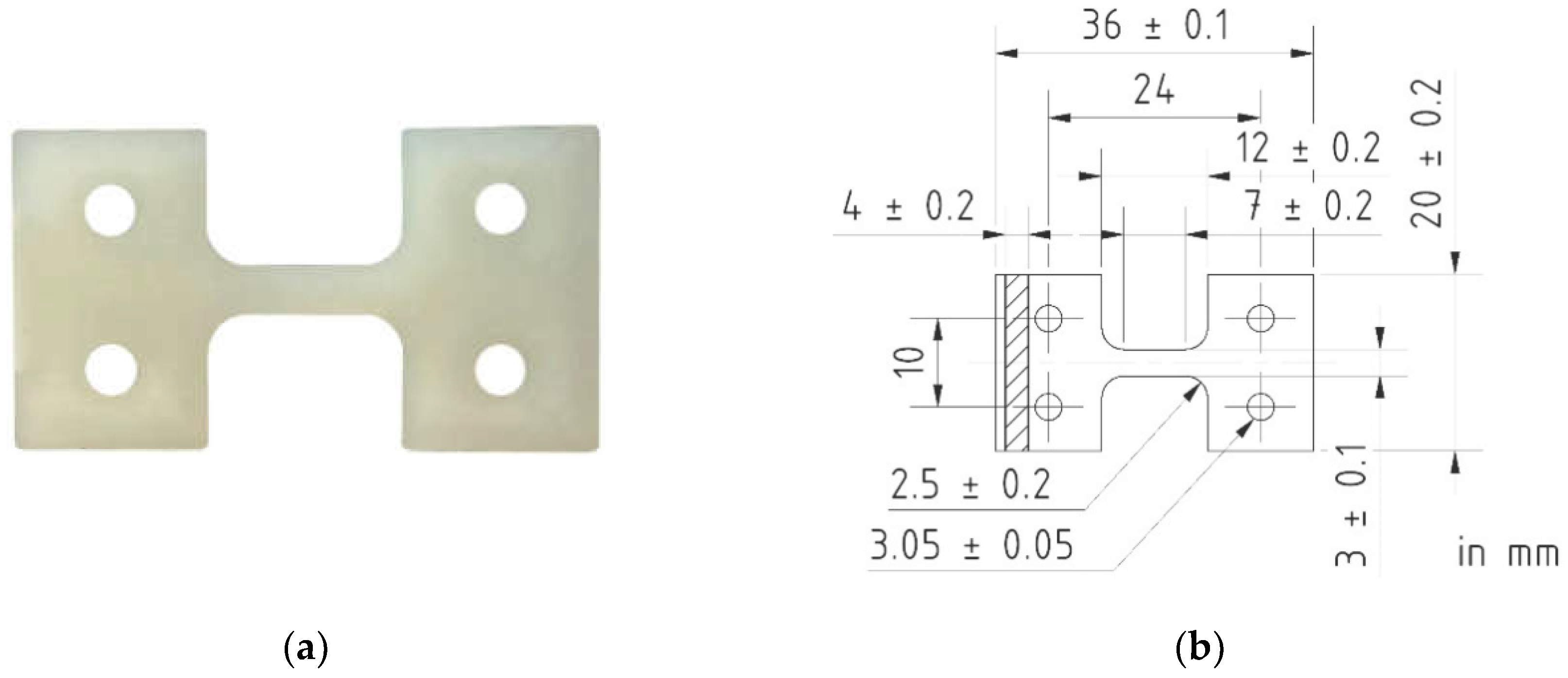
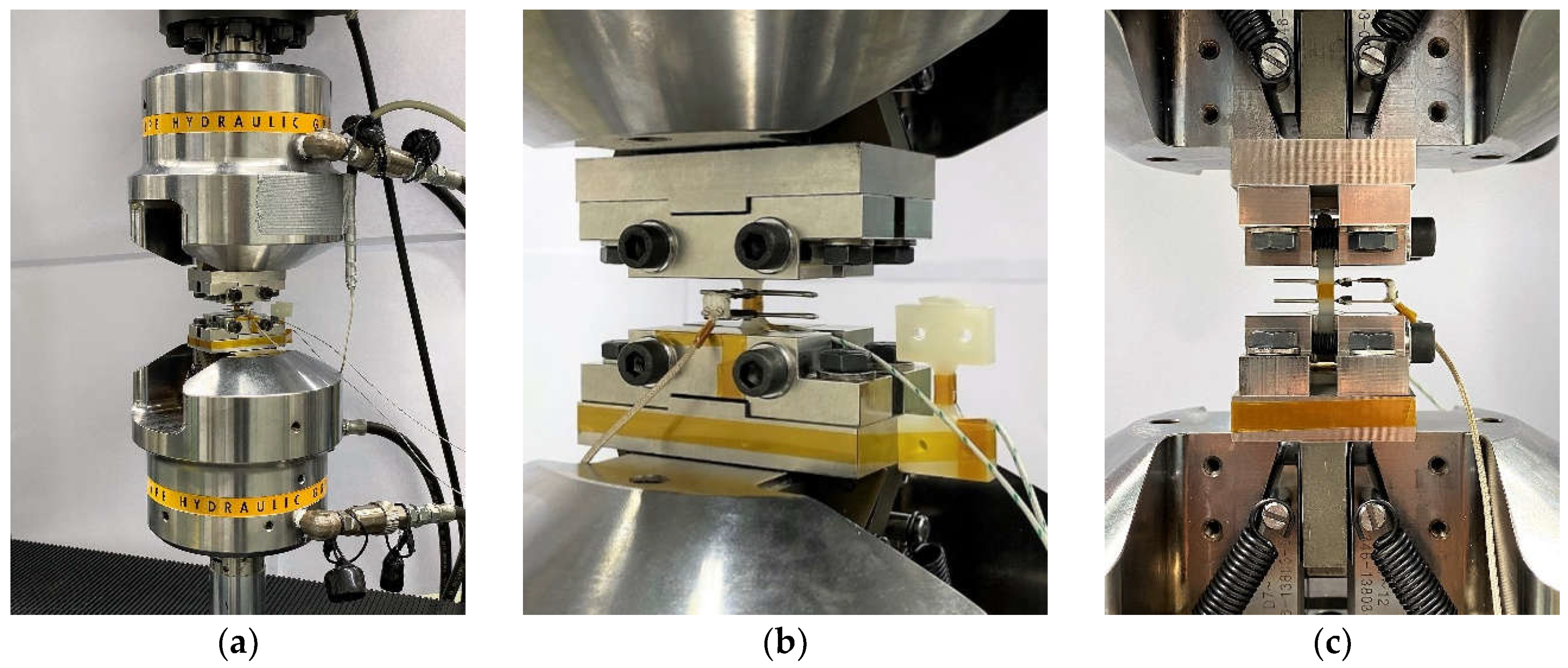
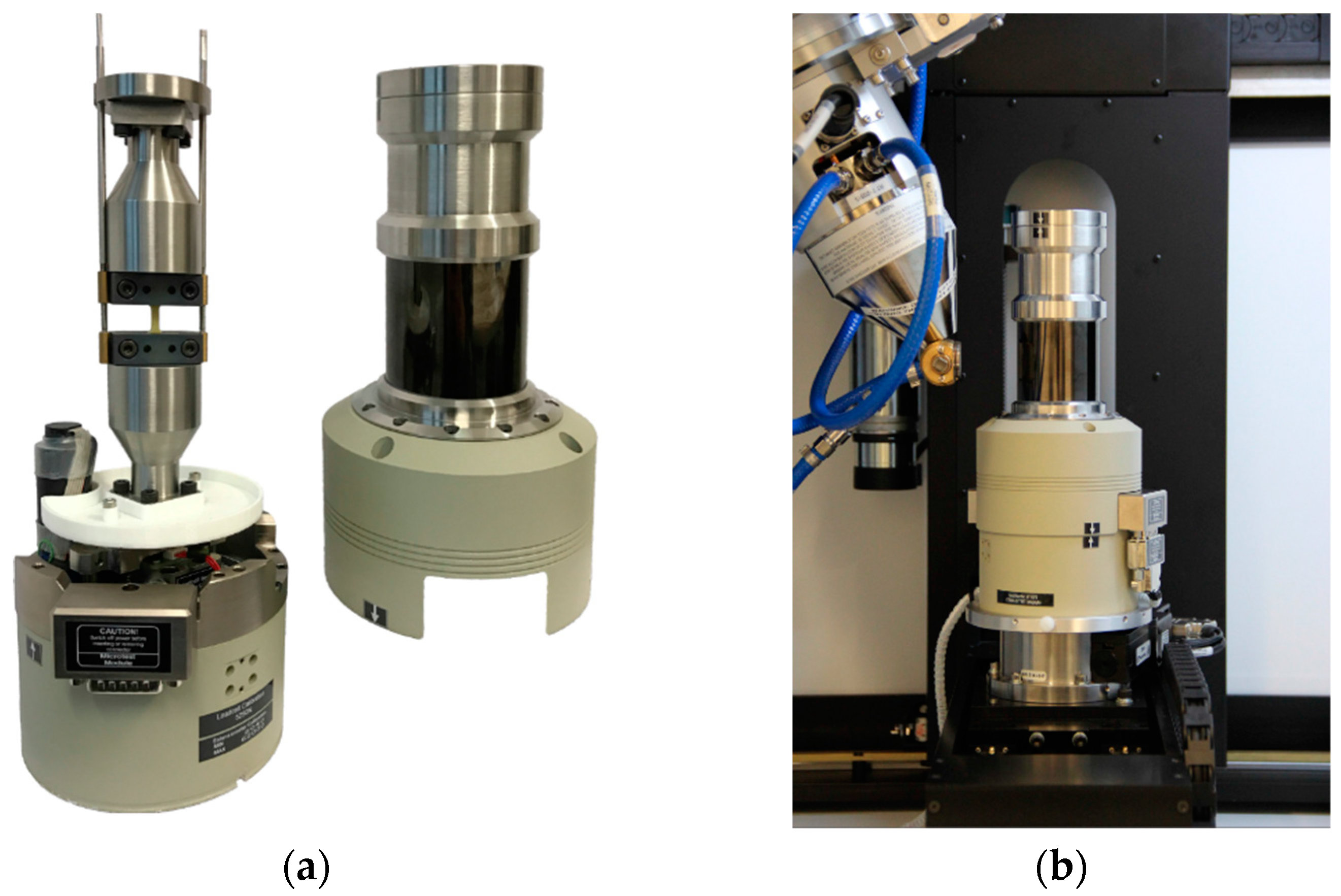
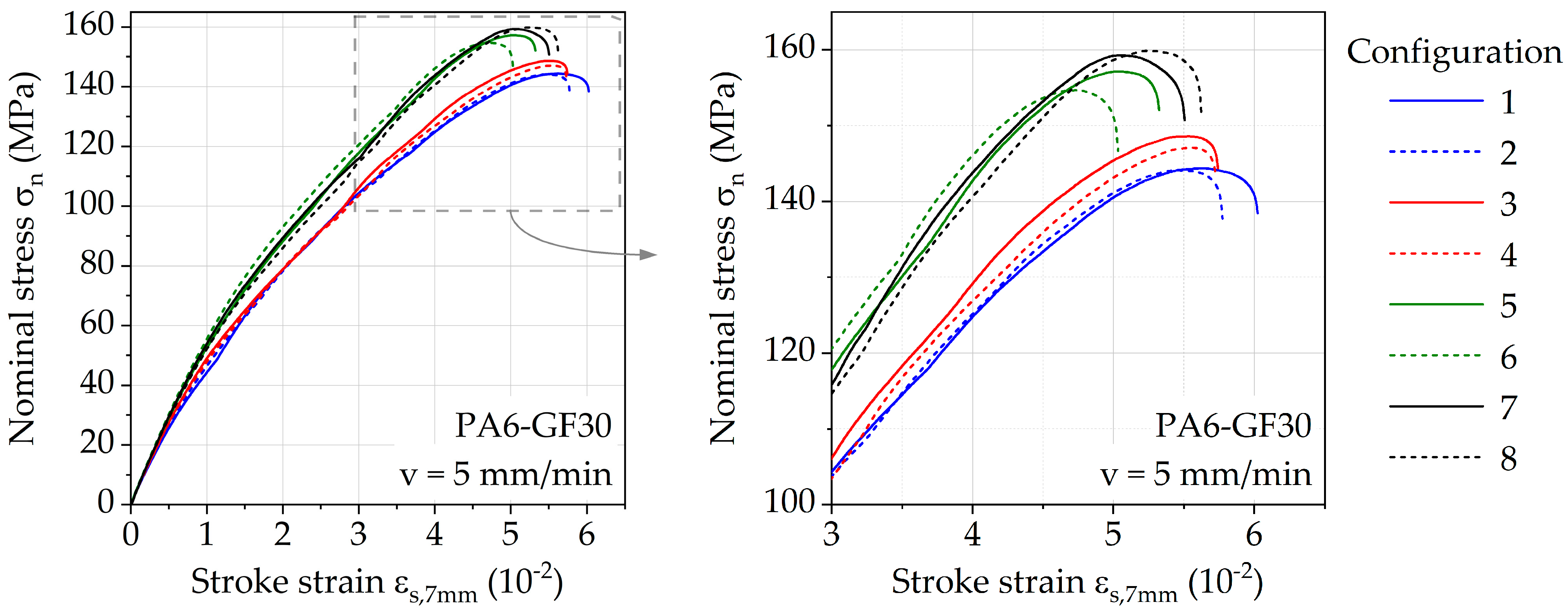
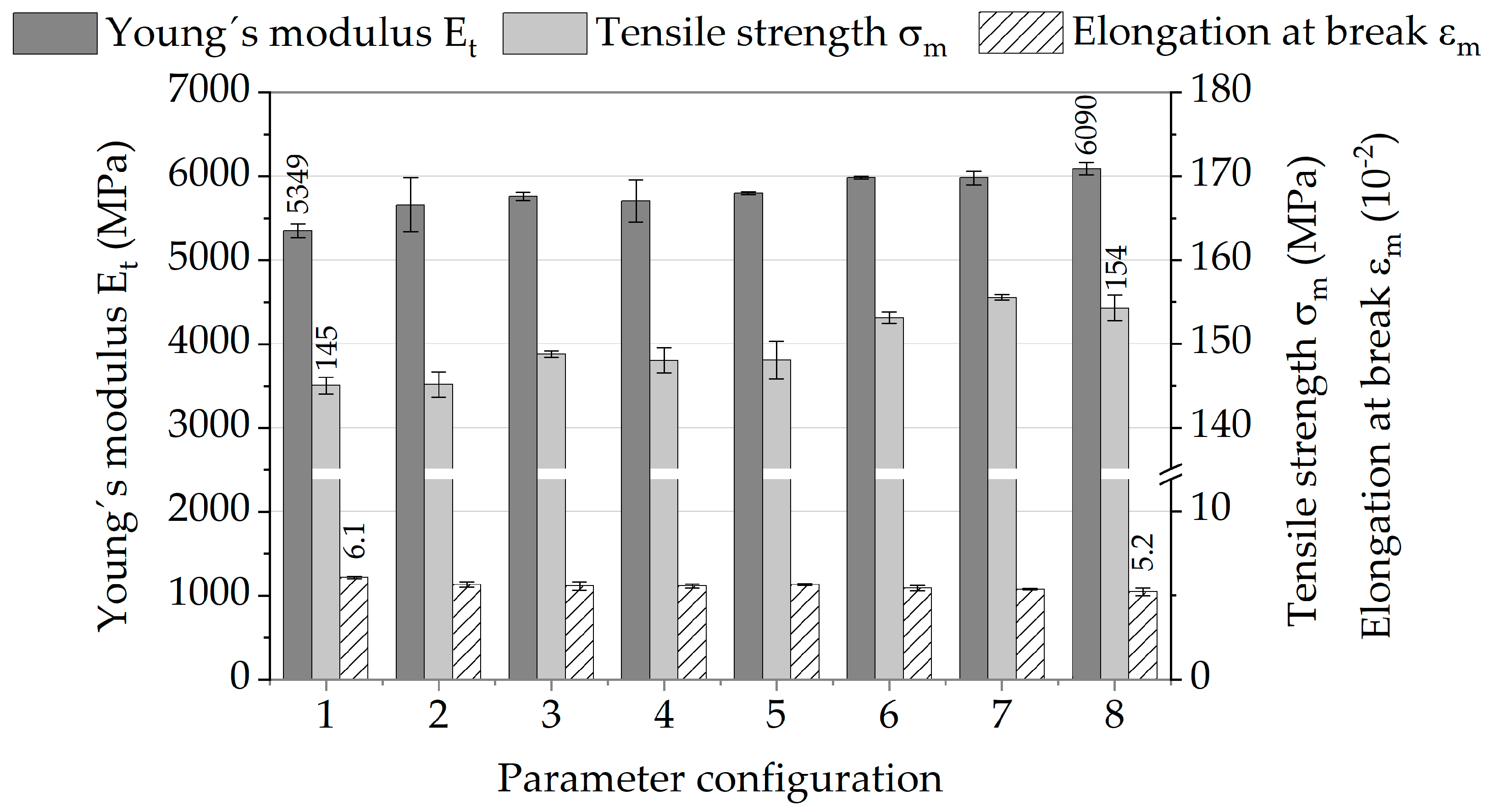

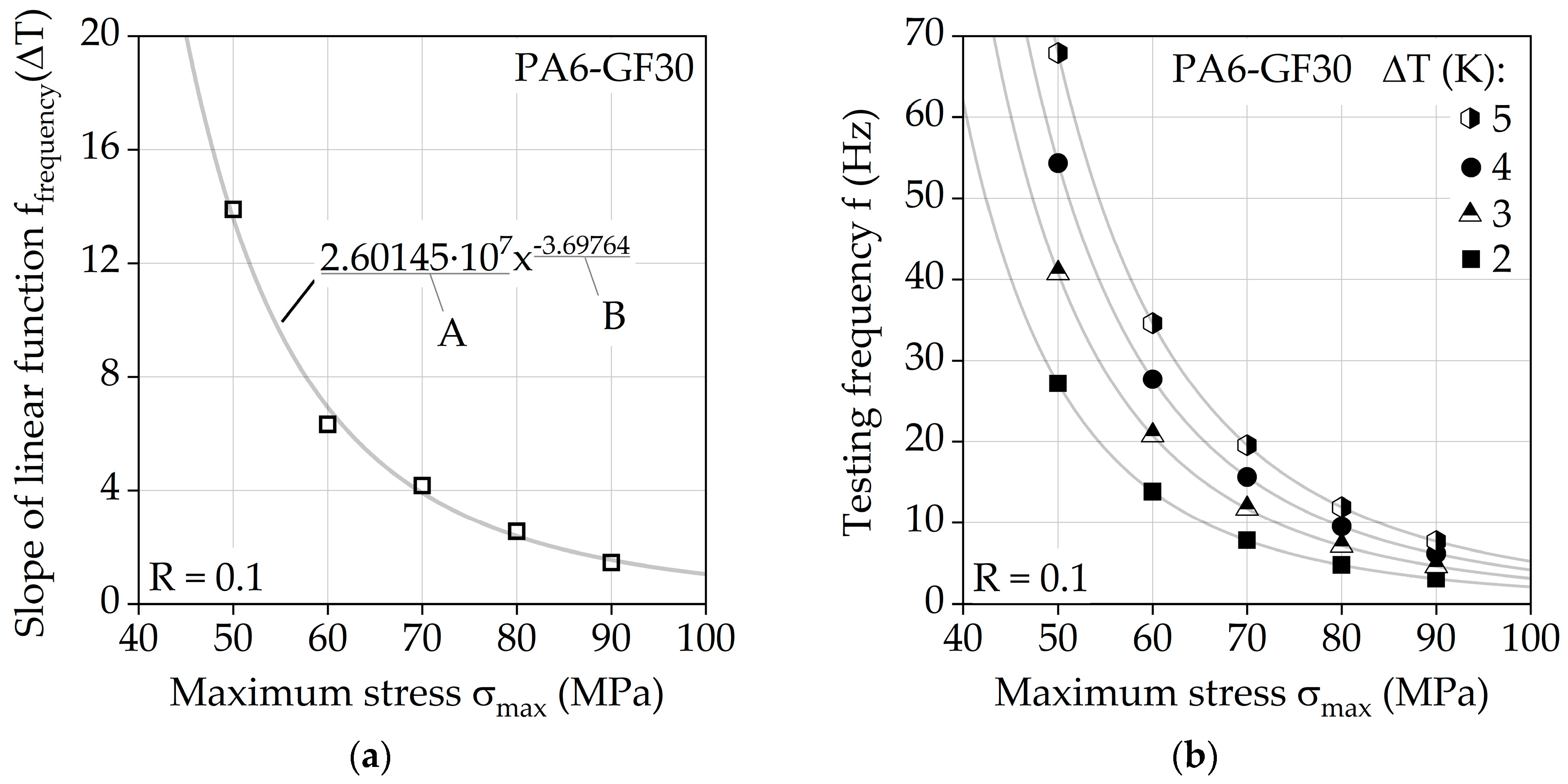

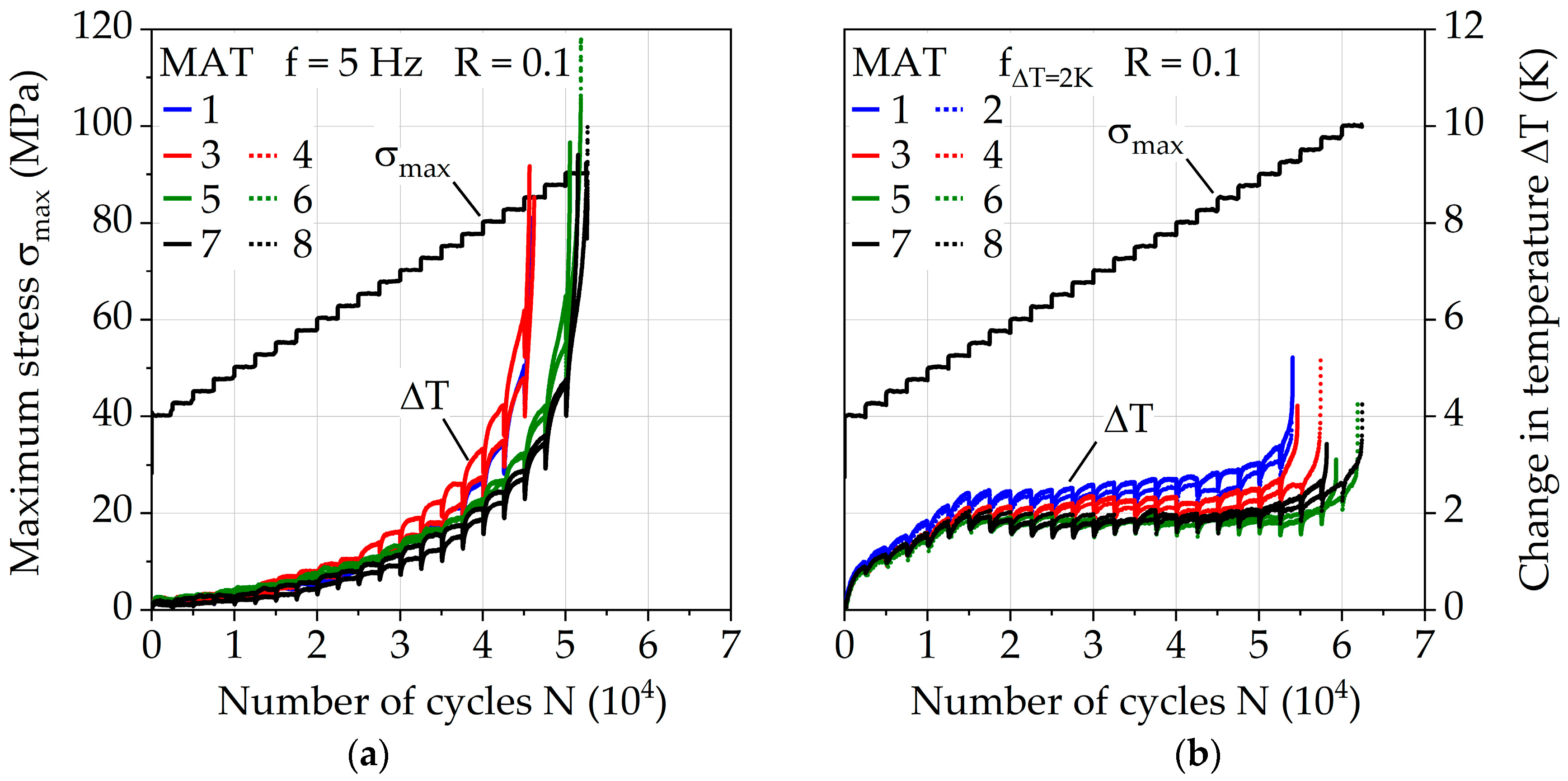
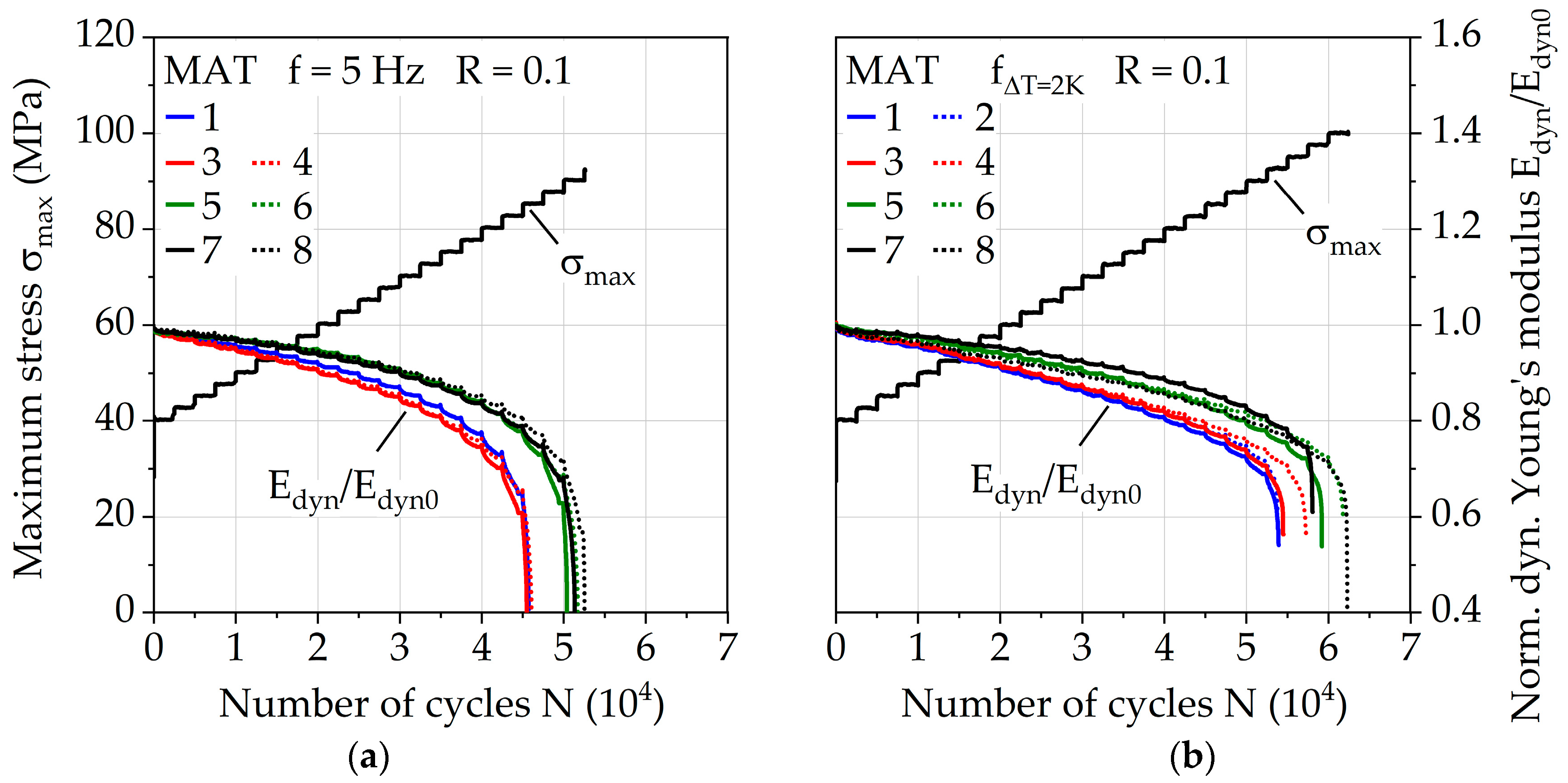
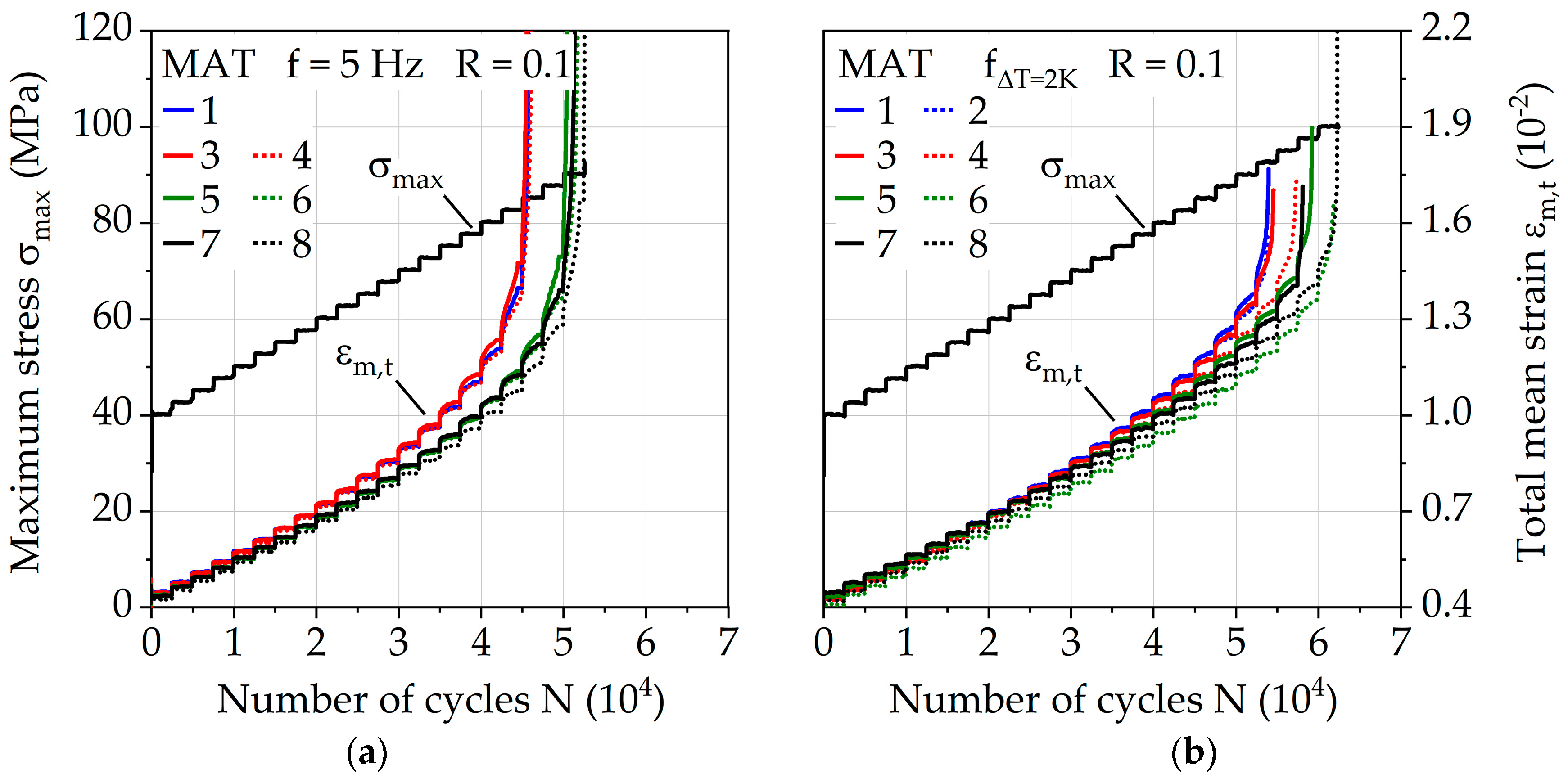

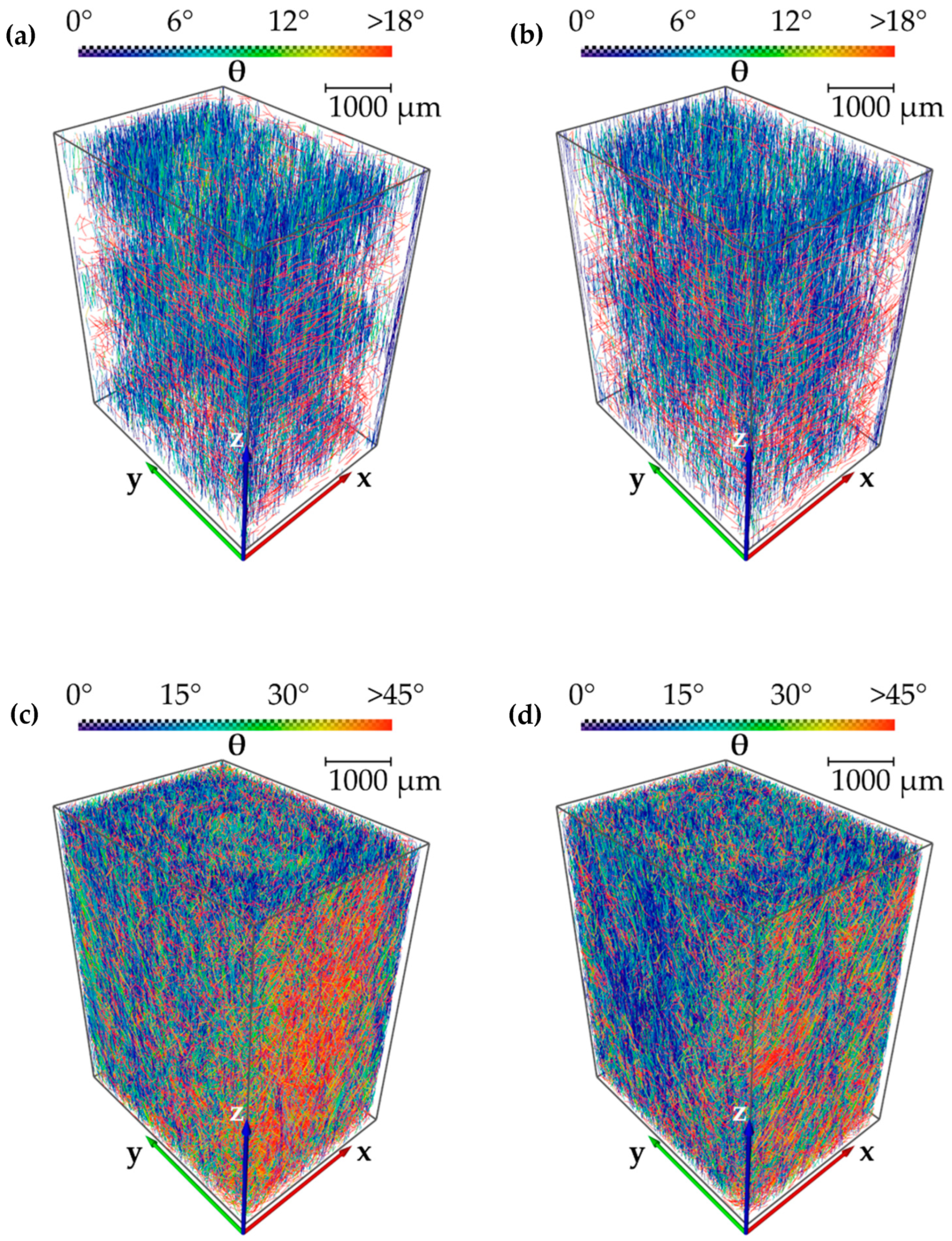
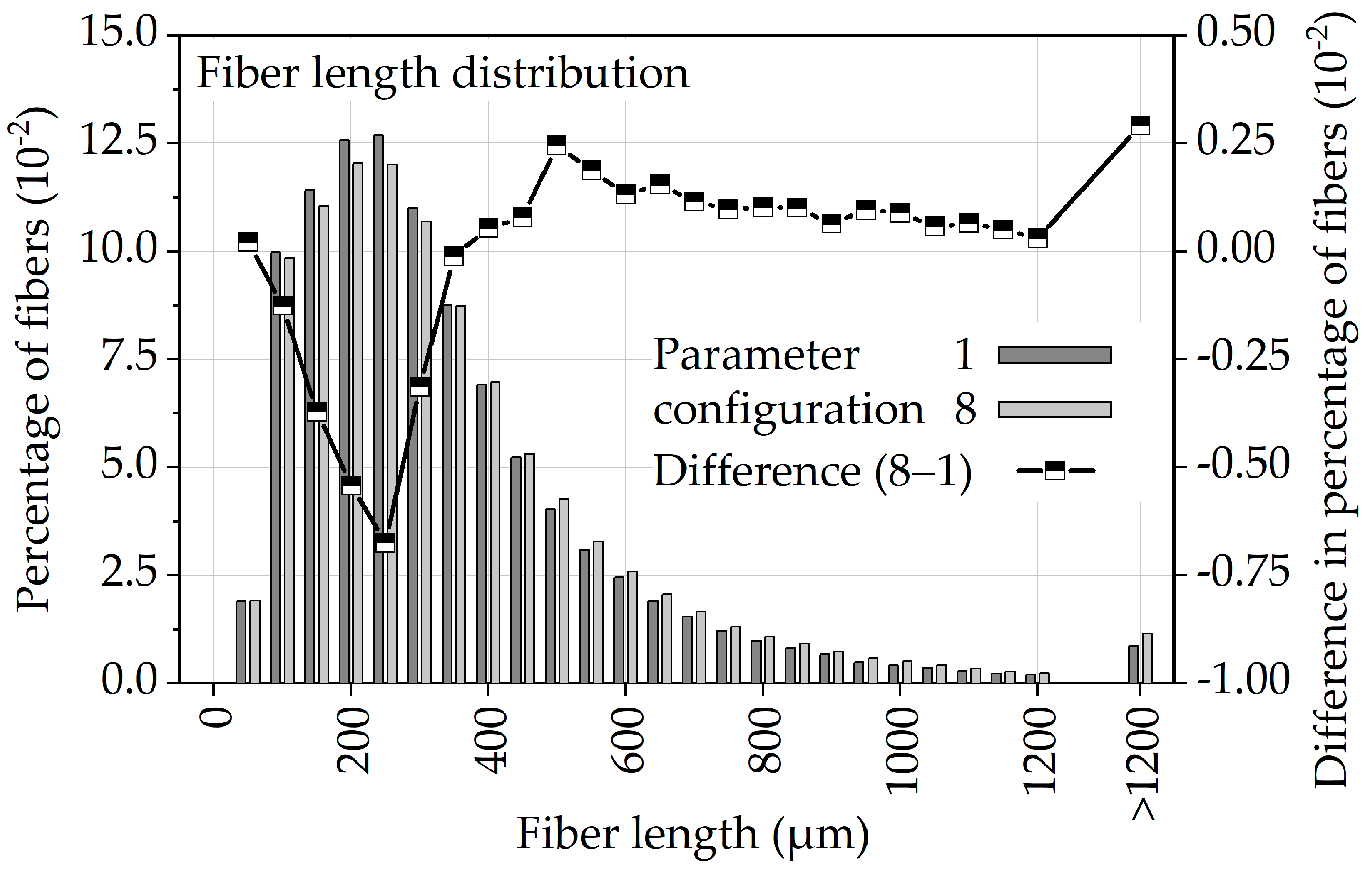

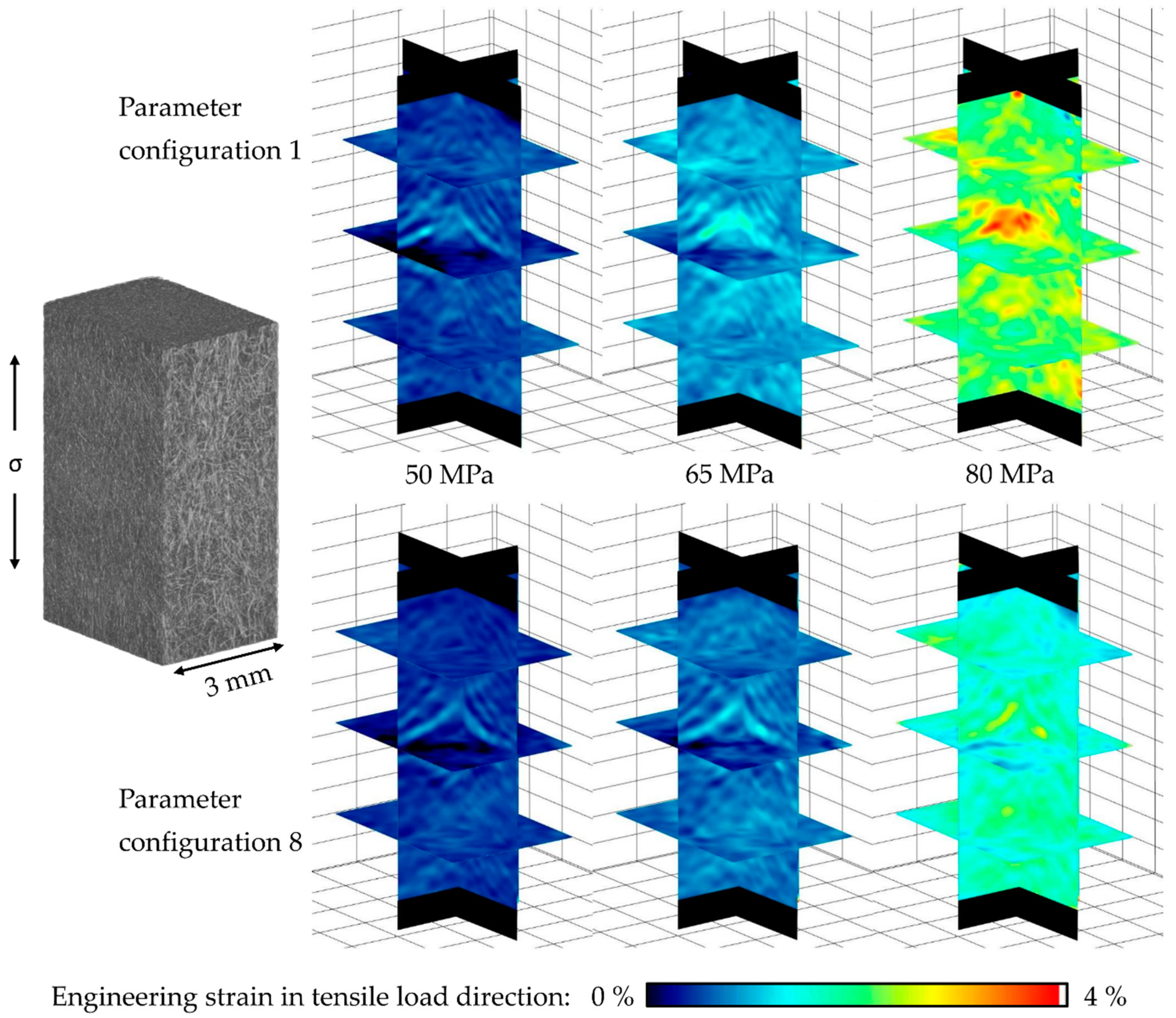
| Configuration [–] | Melt Temperature [°C] | Mold Temperature [°C] | Volume Flow Rate [cm³/s] |
|---|---|---|---|
| 1 | 250 | 60 | 20 |
| 2 | 250 | 60 | 28 |
| 3 | 250 | 90 | 20 |
| 4 | 250 | 90 | 28 |
| 5 | 290 | 60 | 20 |
| 6 | 290 | 60 | 28 |
| 7 | 290 | 90 | 20 |
| 8 | 290 | 90 | 28 |
| σmax | 50 MPa | 60 MPa | 70 MPa | 80 MPa | 90 MPa |
| fstart | 3 Hz | 2 Hz | 1.5 Hz | 1 Hz | 0.5 Hz |
| Δf | 3 Hz | 2 Hz | 1.5 Hz | 1 Hz | 0.5 Hz |
| X-ray Microtomograph | Zeiss Xradia Versa 520 | Nikon XT H 160 | |
|---|---|---|---|
| Cylinder length | [μm] | 38 | 100 |
| Angular sampling | 5 | 5 | |
| Mask cylinder radius | [μm] | 10 | 10 |
| Outer cylinder radius | [μm] | 6 | 6 |
| Minimum seed correlation | 200 | 150/144 | |
| Minimum continuation quality | 80 | 80 | |
| Direction coefficient | 0.2 | 0.2 | |
| Minimum distance | [μm] | 10 | 12 |
| Minimum length | [μm] | 38 | 100 |
| σmax | [MPa] | 40 | 42.5 | 45 | 47.5 | 50 | 52.5 | 55 | 57.5 | 60 | 62.5 | 65 | 67.5 | 70 |
| fΔT = 2K | [Hz] | 24 | 24 | 24 | 24 | 24 | 22.7 | 19.1 | 16.2 | 13.8 | 11.9 | 10.3 | 9 | 7.8 |
| tN = 2500 | [s] | 104 | 104 | 104 | 104 | 104 | 110 | 131 | 154 | 181 | 210 | 243 | 278 | 321 |
| taccumul. | [s] | 104 | 208 | 312 | 416 | 520 | 630 | 761 | 915 | 1096 | 1306 | 1549 | 1827 | 2148 |
| σmax | [MPa] | 72.5 | 75 | 77.5 | 80 | 82.5 | 85 | 87.5 | 90 | 92.5 | 95 | 97.5 | 100 | |
| fΔT = 2K | [Hz] | 6.9 | 6.1 | 5.4 | 4.8 | 4.3 | 3.8 | 3.4 | 3.1 | 2.8 | 2.5 | 2.3 | 2.1 | |
| tN = 2500 | [s] | 362 | 410 | 463 | 521 | 581 | 658 | 735 | 806 | 893 | 1000 | 1087 | 1190 | |
| taccumul. | [s] | 2510 | 2920 | 3383 | 3904 | 4485 | 5143 | 5878 | 6684 | 7577 | 8577 | 9664 | 10,584 |
Publisher’s Note: MDPI stays neutral with regard to jurisdictional claims in published maps and institutional affiliations. |
© 2021 by the authors. Licensee MDPI, Basel, Switzerland. This article is an open access article distributed under the terms and conditions of the Creative Commons Attribution (CC BY) license (https://creativecommons.org/licenses/by/4.0/).
Share and Cite
Mrzljak, S.; Delp, A.; Schlink, A.; Zarges, J.-C.; Hülsbusch, D.; Heim, H.-P.; Walther, F. Constant Temperature Approach for the Assessment of Injection Molding Parameter Influence on the Fatigue Behavior of Short Glass Fiber Reinforced Polyamide 6. Polymers 2021, 13, 1569. https://doi.org/10.3390/polym13101569
Mrzljak S, Delp A, Schlink A, Zarges J-C, Hülsbusch D, Heim H-P, Walther F. Constant Temperature Approach for the Assessment of Injection Molding Parameter Influence on the Fatigue Behavior of Short Glass Fiber Reinforced Polyamide 6. Polymers. 2021; 13(10):1569. https://doi.org/10.3390/polym13101569
Chicago/Turabian StyleMrzljak, Selim, Alexander Delp, André Schlink, Jan-Christoph Zarges, Daniel Hülsbusch, Hans-Peter Heim, and Frank Walther. 2021. "Constant Temperature Approach for the Assessment of Injection Molding Parameter Influence on the Fatigue Behavior of Short Glass Fiber Reinforced Polyamide 6" Polymers 13, no. 10: 1569. https://doi.org/10.3390/polym13101569
APA StyleMrzljak, S., Delp, A., Schlink, A., Zarges, J.-C., Hülsbusch, D., Heim, H.-P., & Walther, F. (2021). Constant Temperature Approach for the Assessment of Injection Molding Parameter Influence on the Fatigue Behavior of Short Glass Fiber Reinforced Polyamide 6. Polymers, 13(10), 1569. https://doi.org/10.3390/polym13101569







